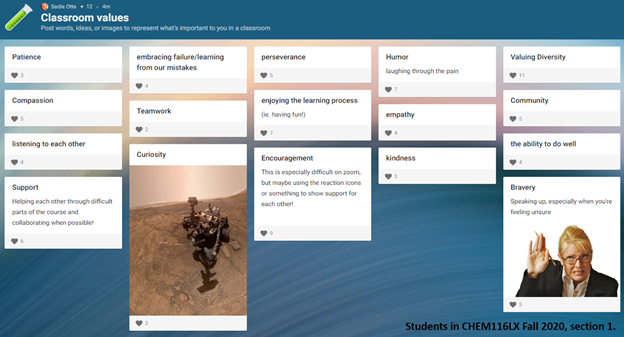In my experience, spontaneous conversations about classroom values can be awkward. Ditto for icebreakers and typical “norm”-setting discussions. Could there be a way to avoid awkwardness by easing the students into the conversation?
Here, I describe a field-tested activity that is especially appropriate for the first day of class. The first day is crucial to set the right tone, and this includes encouraging community building and getting everyone on the same page with how the course will run. Your first class also offers an important, yet often overlooked, opportunity to discuss classroom values, or how the instructor and students would like to be treated in the classroom. This activity manages to accomplish all of these goals in only 15 minutes with the assistance of the Padlet tool.
Padlet is a free virtual education tool that functions like a large board covered in Post-It notes. Users can post text, images, links, or other digital content. Posts can be made anonymously, you can allow for upvoting and/or commenting, and you can customize the design.
On the first day of class, I share a Padlet link with students and ask them to post words, ideas, or images to represent what is important to them in a classroom. The Padlet is already set up with my classroom value as a sample post: “Bravery: Speaking up, especially when you’re feeling unsure,” with an attached image of a person tentatively raising their hand. The students quickly fill in the bulletin board with other posts such as, “Collaboration,” “Respect,” “Fun,” etc. I give students several minutes to make as many posts as they want, and to comment on or upvote other entries. Then, I congratulate them on an excellent list of values, which is delightfully the case since students respond so well to the invitation this activity provides. I ask them to choose one other post besides their own and share what they like about it. I start by choosing a value and explaining why I appreciate it (I usually choose one without a lot of comments or upvotes). Then, I mute myself and stay muted while the students talk. If I am lucky, they start to forget I am there as the conversation unfolds.
I expect the reason this activity avoids awkwardness so well is that it eases the students into the conversation at each step of the way. Posting a single word on Padlet anonymously is a low-barrier action. After you have made one post, it is not much of a stretch to add a comment. Everyone is posting at the same time, so the board is constantly growing, keeping it engaging. By the time they feel as if they want to unmute themselves, someone has probably already said something nice about their own post, encouraging them to return the favor. They may also want to draw attention to a value that is important to them, but they had not thought of themselves.
The amazing thing is that once a few people have shared (and I am staying quiet), the students will start to open up. Students who would normally never unmute are suddenly talking about their imposter syndrome or how isolated they feel when everyone turns their cameras off. Others are quick to echo these feelings and add requests to form study groups or WhatsApp channels to foster connection. By the end, there is a strong feeling of camaraderie and accountability. I make sure to revisit the Padlet a few weeks later to rekindle engagement as things start to get busy and participation may start to wane from the standards they had envisioned.
For the Padlet settings, I set the title to “Classroom Values.” For the description, I write “Post words, ideas, or images to represent what’s important to you in a classroom.” I set the wallpaper and icon to something science-y since I teach chemistry. I turn off attribution (i.e., so posts are anonymous), set new posts to appear first, turn on comments, and set the reactions to enable “likes.” It is also important to adjust your privacy settings to allow visitors to write, especially if you are copying an existing Padlet to use it for another class.
In addition to benefitting the students, I have learned a lot from these activities. Posts like “Silence: Sometimes people just need a few moments to think,” and “Transparency: Give us feedback if something can be improved” have helped me adjust my own teaching and personalize my teaching style for each section’s preferences. Other colleagues who have tried this activity in their own classrooms reported back on similar successes and encouraged me to share it more widely.

Sadie Otte is the organic chemistry laboratory coordinator at Scripps, Pitzer, and Claremont McKenna Colleges in Claremont, California.
Reference
Padlet (2020). Retrieved from https://padlet.com/






